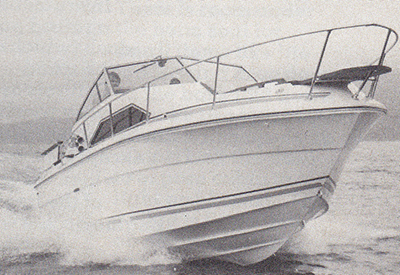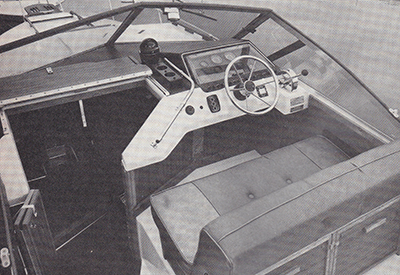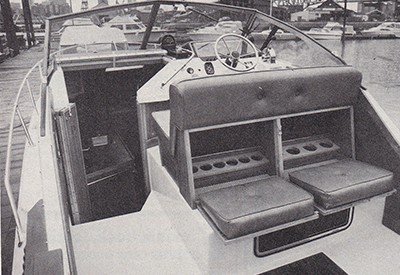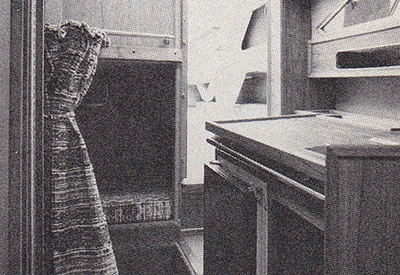Sea Ray SRV 245 Sundancer
Written by Andy Adams, Photographs by John Lund.
Weekend comfort in Sea Rays Sundancer
Sea Ray has a long standing tradition of building nice boats, which likely accounts for their position as number one in boat building,a according to figure i saw recently. They have a family large range of models – all well built and attractively styled. Our test boat was a SRV 245 Sundancer, and it reflected some of the best that Sea Ray has to offer.
The builder has redesigned the Sundancer for 1980 with an altered hull and other changes that have resulted in a very impressive weekender. Before, the Sundancer had a reverse flow venturi-type windscreen surrounding the entire cockpit; to see it, you’d think it was a big green plexiglass flower in full blossom. That windscreen is still available but since its of very limited practicality in these parts. Sea Ray wisely decided to offer a skiff-type windshield this year as an option. Our boat was equipped with this.
 With the Sundancer, Sea Ray has followed a new trend towards weekender boats offering runabout levels of performance and style along with accommodation for four, without sacrificing comfort. To achieve this, the design starts with a 24 ft 7 inch hull and a 96 inch beam.
With the Sundancer, Sea Ray has followed a new trend towards weekender boats offering runabout levels of performance and style along with accommodation for four, without sacrificing comfort. To achieve this, the design starts with a 24 ft 7 inch hull and a 96 inch beam.
To help those of you caught without your calculators, that’s a beam of 8 ft for trailering; the boat weighs about 4,500 lbs, though, so you won’t be pulling it with a Honda. For its size it’s relatively light and, with car, it’ll go behind a station wagon or similar vehicle. Part of the reason the Sundancer will trailer easily is the overall low profile for clearance under bridges.
The low profile is also a reason why the Sundancer handles as well as it does. It does not experience the windage problems flying-bridge boats invariably have when docking or in a strong blow, and the centre of gravity is well down for spirited cornering.
 A weekend-type boat is for fun and sun, so the deck design should be tailored with that in mind. The Sundancer has a full stainless steel bow rail so that the molded-in seats on the foredeck can be used safely. Leaning back against the cabin front as you sit on the deck, you’ll get a breeze and a tan. More people can sit on the aft deck in lounge chairs and such, but it might be best not to move from one area to the other under way.
A weekend-type boat is for fun and sun, so the deck design should be tailored with that in mind. The Sundancer has a full stainless steel bow rail so that the molded-in seats on the foredeck can be used safely. Leaning back against the cabin front as you sit on the deck, you’ll get a breeze and a tan. More people can sit on the aft deck in lounge chairs and such, but it might be best not to move from one area to the other under way.
While the bow rail is sturdy anJ carries well back, the whole boat is low enough that there isn’t really a place for mounting a hand rail where a person could get good purchase. The skiff windshield has been designed with a soft rubber cap so it can act as a handhold, but that’ s not the best idea in case too much weight is placed on it. Then too, the cabin hatch to the deck is over the dinette table, which won’t carry much weight, so it’s best not to put people through that.
The test boat was equipped with the optional teak bowsprit and anchor system, with an anchor locker on the deck covered by a hatch-and-latch combination. I found the latch a bit stiff, but the idea is good. It’s hinged at the back and one wouldn’t want the hatch to lift at speed.
 This type of party boat ought to have a swimming platform, and it does. Sea Ray has fitted a good-looking teak grid (with a swing-down ladder as well) and there is a break in the teak taff rail surrounding the cockpit with a step pad for swimmers.
This type of party boat ought to have a swimming platform, and it does. Sea Ray has fitted a good-looking teak grid (with a swing-down ladder as well) and there is a break in the teak taff rail surrounding the cockpit with a step pad for swimmers.
A good feature of the cockpit is the curtain that’s available, for below the taff rail, to divert cool breezes; it also continues the cabin-side graphics to give a handsome unified look to the boat.
The cockpit is a generous size for this length and offers ample room for fishing and sunning. Our test boat had the optional live well, an upholstered top box to act as a stern bench seat, equipped with side handles so it can be carried on and off the boat easily. When in place, it is secured by hook and eye latches. On a boat where space is important, this makes good sense.
Engine access is through a teak floor hatch. A second hatch ahead of that opens to reveal the water works. I like the teak hatches – they add a nautical look and a warm feel – but it would be best to keep the top up and stern curtains on when the boat isn’t in use. That way you can enjoy the teak instead of working on it.
 At the leading edge of the cockpit floor is a raised area with a sliding window (more on that later), and above that a pair of drop-down doors on the back of the helm seat. I was quite surprised to find that the doors drop to make two very comfortable jump seats, located well out of the breeze, and that behind them are a liquor cabinet on one side, and a rack for glasses on the other. This was nicely done and will be well used by most owners, I’m sure.
At the leading edge of the cockpit floor is a raised area with a sliding window (more on that later), and above that a pair of drop-down doors on the back of the helm seat. I was quite surprised to find that the doors drop to make two very comfortable jump seats, located well out of the breeze, and that behind them are a liquor cabinet on one side, and a rack for glasses on the other. This was nicely done and will be well used by most owners, I’m sure.
All around the cockpit sides, there’s room for storage , some open, some enclosed, and the raised area under the helm seat drops again at the port side to make a walkway forward. Except for the teak hatches, all flooring is safely non-slip fibreglass.
The one and only helm area on the Sundancer is on the raised portion of the decking. One takes one step up from the port side walkway and a handhold is conveniently placed there for that purpose. The helm seat is a single bench that’s fine for two but a bit of a pinch for three. It is comfortable though, and offers an excellent view outward. The skiff windshield keeps out the drafts, but flip-open side vents can bring in huge amounts of cooling air when needed.
There is storage room under the helm seat for life jackets and small stuff, and the seat itself is far enough back that standing or kneeling operation is possible. Generally, one would sit to drive the SRV 245, and it is most comfortable this way. Our test boat had a single Mercruiser 260, sterndrive, so only one set of controls, placed up on the dash to starboard, had to be included. The wheel is at an angle but is small-rimmed and basically good. The instruments live in a raised pod on the dash (again, more on that later) and the gauges are under a lift-up clear plexi-cover with a teak handle and teak trim. Switches are joined by their fuses and lamps where needed, and the trim tab controls and power tilt flank the wheel.
 A compass was also fitted but was Otherwise, the helm is excellent, with good vision, all controls in easy reach, everything clearly marked and all operations requiring a light touch. This is a very responsive boat.
A compass was also fitted but was Otherwise, the helm is excellent, with good vision, all controls in easy reach, everything clearly marked and all operations requiring a light touch. This is a very responsive boat.
On the port side of the dash is a teak hatch and piano-hinged door leading to the cabin. In the full open position, this arrangement opens up almost half of the dash to admit light and breezes to the cabin. It makes getting in and out easy and looks very nice.
Entering the cabin, which really lies below-decks, your first view is of the galley unit ahead of you on the port side. This is cut in at an angle fore and aft to give room for walking around the cabin while providing maximum counter area.
The galley is fitted with a two-burner alcohol/electric optional stove and 12/ 120V refrigerator. There was also optional shore power in the test boat with an outlet handy to the galley. An interesting feature on the Sea Ray is the sliding flexible track dooring used in several places. This is like the cover on a roll top desk and allows the builder to give quite a large opening cupboard without needing room for the door to swing. It’s a neat solution.
Ahead of the galley is the V berth, measuring about 78 in. long by 72 in. wide with the filler cushion, which has the dinette table in the middle. The table itself is a fair size and has a fold down leaf at the aft end. With the leaf down you could seat and feed four people easily, with room to spare.
There’s storage under the berths, and a hanging locker at the aft end for the starboard side. This lies against the head, which is fitted with a Sani-Pottie toilet, pressure water, a sink in a vanity and storage beneath.
 I have mentioned the pod on the dash where the instruments are mounted. Well, Sea Ray calls this a fully-enclosed stand-up head, and it’s true. My head fit into the dash top raised area perfectly, snug against the ceiling. They can justify their claim, but not by much.
I have mentioned the pod on the dash where the instruments are mounted. Well, Sea Ray calls this a fully-enclosed stand-up head, and it’s true. My head fit into the dash top raised area perfectly, snug against the ceiling. They can justify their claim, but not by much.
Headroom in most of the cabin runs to around 6 ft 2 in. and the sliding side glass helps give a more open feeling, but this is not a very large boat and Sea Ray had to do some fancy work to get everything in. It’s all there though – and mostly done in teak, which is handsome.
I said I’d have more to say on the sliding window in the stern cockpit below the jump seats. This is the window to the aft berth, lying athwartship under the helm area. In a 24-footer, a second, enclosed room is unexpected, but the Sundancer has it. This includes a double berth and room to walk in and lie down. The berth itself is comfortable and cozy, but there’s only 25 in. of space over it. As long as nobody sits up suddenly at night, the aft berth has enough clearance, and is a real plus in this size and price boat.
So there you have it – a trailerable weekender with all the comforts of home, room for four (easily), lots of sunning space and a reasonable as-tested price of $31,289 (1980 price). The only question left is how it goes.
The answer is – beautifully. The Mercruiser 260 sterndrive is the standard power, enough to push the test boat to 40.5 mph, and it wasn’t fully run in yet. As with all Mercruiser sterndrives, this has power tilt and trim, and being a VS model, it bas power steering too. It’s light to the touch, deadly accurate and never binds or tightens up. It does, however, offer a nice feel that’s often lacking in hydraulic systems.
The SRV 245 has 17 degrees of dead rise at the transom, which seems pretty tame these days with some other boats going as high as 22 degrees in the same size range, but that didn’t stop the Sundancer from having a solid, soft ride. The bow lift strakes end about 6 ft ahead of the transom so that area can absorb more of the impact smoothly, and it also serves to keep the prop in solid touch with the water.
Sea Ray claims a new bow shape that assists planing on this hull for 1980, and we found the boat would pick up with a real rush. It didn’t cavitate and skiing behind it is a definite possibility. The handling in turns is excellent, with subdued roll and a tremendous grip on the water.
Our test Sundancer was equipped with the optional hydraulic trim tabs. With these down a bit, we could hold the plane down to almost 2,000 rpm. That’s showing off, but without the tabs, the SRV 245 was solidly planing at 2,500 rpm, doing 20 mph. At this rate, you could look for pretty respectable fuel economy too, although we weren’t able to come up with official figures there.
The Mercruiser 260 is a lovely power plant, producing lots of torque to spin the 153/4-in. by 17-in. three-blade prop and running smoothly and effortlessly at all times. The boat is well insulated for sound: it’s comfortable on the bridge and the cabin (except the athwartship berth) is always quiet enough for easy conversation. Previous experience suggests that the 260 will be a dependable engine without bringing a bad fuel penalty for the great top speed.
The Sundancer has a very fancy interior with lots of teak joinery work and other labor -intensive features, and although it is a single engine boat with only one helm, it still seems to .be an attractively priced package at a $29,000 (1980 pricing)-or-so base price. This isn’t a boat I’d want for a two-week vacation with three other people, but for a weekend with four adults or with the kids, it would be just great.
Originally published in Canadian Yachting’s March 1980 issue.
Specifications:
Length – 24ft 7in
Beam – 8ft
Weight 4,500 lbs
Fuel Capacity – 100 gallons
Engine – Mercruiser 260 sterndrive
Photo Captions:
Photo 1 – Water-skiers will love the smooth ride, quick pick up and tremendous grip through turns in the SRV 245.
Photo 2 – Sea Ray claims a new bow shape and altered hull that assist planing, and there’s still lots of deck space for sunning.
Photo 3 – Instruments live on a raised pod on the dash (which encloses the stand-up head). Controls are within easy reach and the driver has good vision except for the compass which is slightly out of the line of sight.
Photo 4 – Engine access is through a teak floor hatch.
Photo 5 – There is room under the helm seat for small items like lifejackets and drop doors on the back fold down to make two jump seats. A teak hatch opens up almost half the dash to expose cabin to light and breeze.
Photo 6 – Dinette.
Photo 7 – The galley is fitted with an alcohol/electric stove and refrigerator.






















